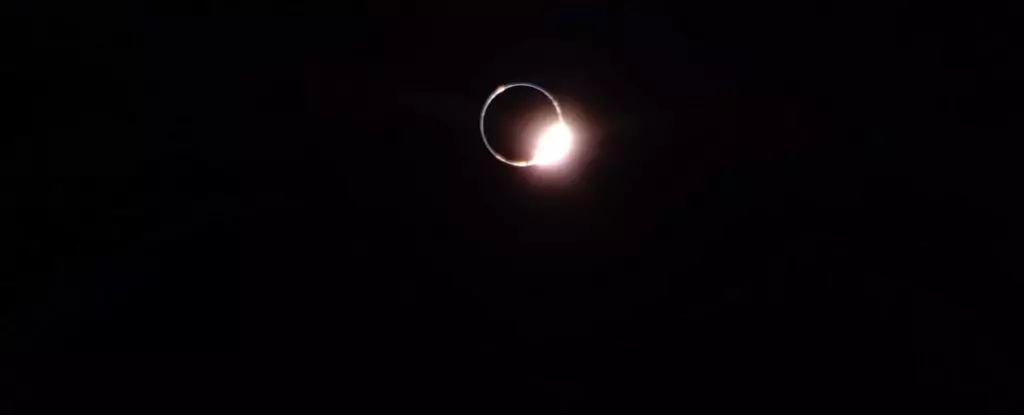In a historical moment that bridges human ingenuity and celestial wonders, the Blue Ghost lander from Firefly Aerospace has captured an extraordinary phenomenon that eludes most of humanity—the total solar eclipse as observed from the Moon. This remarkable sight occurred as Earth eclipsed the Sun, casting a shadow on the lunar surface, an event that had never before been witnessed by any commercial entity actively operating on the Moon. As Earth’s silhouette blotted out the Sun from the moon’s desolate landscape of Mare Crisium, the Blue Ghost provided a rare glimpse into the cosmic dance of celestial bodies.
This event is not merely a spectacle; it represents an intersection of technological prowess and a deeper understanding of the universe. The alignment of the Earth, Moon, and Sun—termed syzygy—is a celestial occurrence that epitomizes the intricate ballet of astronomical bodies and has fascinated humans throughout history. Yet, the true intrigue lies not just in the observation, but in the context of the mission itself, showcasing how far modern space exploration has come since the last human footsteps graced the Moon in the 1970s.
Technical Triumph in Harsh Conditions
The technical challenges faced by the Blue Ghost during this eclipse were immense. As a solar-powered entity reliant on sunlight for its operations, the lander had to utilize backup batteries throughout the five-hour duration of the eclipse. Not only was the darkness an obstacle, but the extreme temperature fluctuations on the Moon added yet another layer of complexity. With temperatures plummeting from a scorching 40 degrees Celsius to a bone-chilling -170 degrees Celsius, the environmental extremes highlighted the resilience and engineering prowess behind the Blue Ghost mission. It serves as a reminder that even in the most unforgiving conditions, the pursuit of knowledge finds a way.
Operating on the Moon during such extreme conditions encapsulates the essence of space exploration. It prompts questions about the durability of technology in uncharted territories and what it takes to ensure successful missions in environments that are, quite literally, out of this world. The Blue Ghost’s ability to endure these conditions and deliver significant observations underscores our capacity for innovation in facing cosmic challenges.
Celestial Surprises: Venus and Mercury Join the Show
Astoundingly, the Blue Ghost lander didn’t just record the eclipse—it also documented the presence of Venus and Mercury, two of our closest planetary neighbors. As these planets photobombed the view, they reminded viewers, both human and robotic, of the interconnectedness of our solar system. Seeing these planets next to the Sun in the backdrop of an eclipse magnifies the beauty of celestial mechanics, showcasing a live event that few will ever witness, let alone capture through technology.
The implications of these observations extend beyond sheer aesthetic value. They invite deeper inquiries into the nature of our solar system and the dynamics of celestial bodies that have been a source of fascination for millennia. The universe is alive with partners in this cosmic waltz, and the Blue Ghost’s camera—albeit robotic—becomes a conduit through which we can better understand our place within this vast expanse.
The Race Against Time: A Lunar Day’s Worth of Opportunity
As the lunar day extends for about two Earth weeks, the Blue Ghost’s operational window is defined by a relentless countdown; its time to gather scientific data is far too limited. With impending lunar night, conditions will plummet, and survival becomes increasingly untenable for any machinery dependent on solar energy. The clock is ticking, and the few opportunities for observation become precious and critical.
This constraint further emphasizes the lander’s achievements. Successfully capturing a total solar eclipse while conducting other scientific operations within a finite timeframe raises essential considerations for future missions as humanity strives to explore and inhabit other worlds. The lessons learned from the Blue Ghost’s experience will undoubtedly influence upcoming endeavors in lunar exploration and beyond.
This extraordinary moment in celestial observation not only fuels curiosity but also ignites the passion to further explore the great unknown. The Blue Ghost, despite being a metal and silicon machine, becomes more than just an instrument; it is a harbinger of what might be possible when human ambition and technology collide against the backdrop of the cosmos. In its single lunar day, this lander is set to leave an indelible mark, capturing the imaginations of scientists and dreamers alike.

